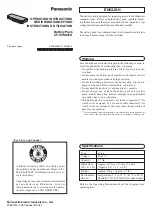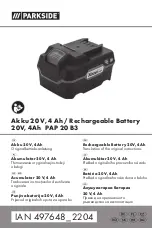
Powering the Charger with an Inverter
or Generator
The charger will operate with most generators and
inverters rated at 100 Watts or higher.
Mouting to the Wall
Use the ribs on the bottom of the charger to mark
the hanging points.
Marking
Ribs
Maintenance and Storage
Store your charger in a cool, dry place.
As a general practice, it is best to unplug battery
chargers and remove batteries when not in use.
No battery pack damage will occur, however, if the
charger and battery pack are left plugged in.
WARNING
To reduce the risk of injury, always
unplug the charger and remove the
battery from the charger before performing any
maintenance. Never disassemble the battery or
charger. Contact a MILWAUKEE service facility
for ALL repairs.
To reduce the risk of injury and damage, never
immerse your battery or charger in liquid or allow
a liquid to flow inside them.
Cleaning
Clean out dust and debris from charger vents and
electrical contacts by blowing with compressed air.
Use only mild soap and a damp cloth to clean the
battery pack and charger, keeping away from all elec-
trical contacts. Certain cleaning agents and solvents
are harmful to plastics and other insulated parts.
Some of these include gasoline, turpentine, lacquer
thinner, paint thinner, chlorinated cleaning solvents,
ammonia and household detergents containing am-
monia. Never use flammable or combustible solvents
around batteries, charger, or tools.
CHARGER
OPERATION
WARNING
Charge only MILWAUKEE M4™
Lithium-Ion batteries in the M4™
MILWAUKEE Lithium-Ion Charger. Other types of
batteries may cause personal injury and damage.
When to Charge the Battery Pack
Remove the battery pack from the tool for charging
Remove the battery from the tool for charging when
convenient for you and your job. MILWAUKEE bat-
teries do not develop a "memory" when charged
after only a partial discharge. It is not necessary to
run down the battery before placing it on the charger.
•Use the Fuel Gauge (on the tool) to determine when
to charge your MILWAUKEE Lithium-Ion battery.
• You can "Top-Off" your battery's charge before start-
ing a big job or long day of use.
• The only time it is necessary to charge the
MILWAUKEE Lithium-Ion battery is when the bat-
tery has reached the end of its charge. To signal the
end of charge, power to the tool will drop quickly,
allowing you just enough power to finish making a
cut, drilling a hole, or driving a fastener. Charge the
battery as needed.
How to Charge the Battery
Align the large tab on the battery with the large slot
in the bay and slide the battery into the charger as
far as possible.
The red light will come on, either flashing (battery
is too hot or cold) or continuous (pack is charging).
• A fully discharged battery with an internal tem-
perature in the normal range will charge in about 45
minutes (between 32°F and 140°F). Heavily cycled
batteries may take longer to charge completely.
• After charging is complete, the continuous green
light will come on.
• The charger will keep the battery fully charged if it
is left on the charger.
• If the light indicator flashes red and green, check that
the battery is fully seated into the bay. Remove the
battery and reinsert. If the light continues to flash
red and green, the battery may be extremely hot or
cold, or wet. Allow the battery to cool down, warm up,
or dry out and then reinsert. If the problem persists,
contact a MILWAUKEE service facility.
• If the light indicator does not come on, check that
the battery is fully seated into the bay. Remove the
battery and reinsert. If the light indicator still does
not come on, contact a MILWAUKEE service facility.
Charging a Hot or Cold Battery Pack
The Red Flashing Indicator light on the charger in-
dicates that the battery pack temperature is outside
the charging range. Once the battery pack is within
the acceptable range, normal charging will take place
and the red light will be continuous. Hot or cold bat-
teries may take longer to charge.
Li-Ion Charging Status
Battery
Temperature
Red Indicator
Light
Charging Status
140°F or more
32°F to 140°F
32°F or less
Flashing
Continuous
Flashing
Not charging
Normal charging
Not charging
Check out the collection of batteries and chargers we offer.






















